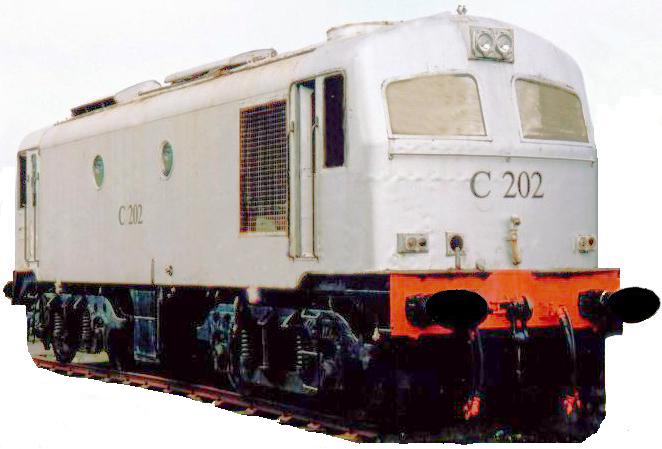- CIE 201 Class
Infobox Locomotive
name = Córas Iarnpair Éireann C class
(later 201 Class)
powertype= Diesel-electric
builder =Metropolitan Vickers ,Dukinfield Works,Manchester
builddate = 1956–1957
totalproduction = 34
primemover=Crossley ESTV8;
Re-engined '69-'80 with EMD 8 cylinder 645E by CIÉ at Inchicore Works,Dublin
transmission = DC generator; DC traction motors
tractionmotors=Metropolitan Vickers MV137CW, 4 off
uicclass=Bo'Bo'
trainbrakes=Vacuum
length = convert|12.8|m|ftin|abbr=on over buffers
width = convert|2.9|m|ftin|abbr=on
height = convert|4.3|m|ftin|abbr=on
weight = convert|62.5|t|lb|abbr=on
topspeed = convert|80|mph|km/h|abbr=on|lk=on
poweroutput="Crossley:" convert|410|kW|hp|abbr=on|lk=on
"EMD:" - convert|820|kW|hp|abbr=on
tractiveeffort = convert|153|kN|lbf|abbr=on|lk=on
fuelc
convert|300|impgal|abbr=on|lk=on
railroad=Córas Iompair Éireann
Iarnród Éireann
railroadclass=C; later 201
roadnumbers=201–234TheCóras Iompair Éireann 201 Class was a class of 34 diesel electric locomotives manufactured byMetropolitan Vickers at their Dukinfield Works inManchester . They were a smaller, lighter and less powerful version of the 001 Class and were originally intended for branch line passenger and freight (mixed traffic) duties. They were introduced in 1956 and, although their duties changed over the years, were in regular service on the Irish railway network until the mid 1980s.Problems and Solutions
Unfortunately, these locomotives suffered from two distinct problems:
* During the late 1950s and early 1960s, following the publication of the Andrews Report, the CIÉ followed a path of large-scale closures of its branch lines, (Similar to that on British Railways following the Beeching Report) leaving them without a purpose.
*The locomotives suffered badly from the unreliability of theirCrossley engines, which were of insufficient power for there duties and suffered reliability problems.Replacement engines:Because of the problems with the Crossley engines attempts were made to fit the locomotives with more suitable equipment. Between 1965 and 1980,
Maybach MD650 engines of convert|980|hp were fitted in No’s 233 and 234. From 1969, however, a permanent solution was to found by fitting the entire class with General Motors engines, a similar process that was also undergone by the 001 Class). New Duties :From 1969 the class were given new duties, being partnered with formerdiesel multiple unit s converted to four-carpush-pull carriage rakes to operate the suburban services aroundDublin . In 1984 the Dublin suburban lines over which they worked were electrified and newelectric multiple unit s operated the renamedDublin Area Rapid Transit (DART) system.The first member of the class to be withdrawn was No.201, being bomb damaged in 1973. The remaining members of the class, except those sold to NIR, were withdrawn over the two years following the opening of the DART system having completed 30 years service for their operators.
Numbering
When built, these locomotives were numbered C201-C234, and as locomotives were re-engined, they were renumbered B201-B234 to reflect their increased power. However, the prefix letter was later dropped.
Livery
Over the years the class have carried six different liveries, some more suited than others. When introduced they were painted an all-over silver livery which unfortunately dirtied quickly and was not a good advert for dieselisation. This was followed by all-over CIE green livery with a thin lighter green band on the lower panels. At least this livery went well with that of the coaching stock giving a uniform appearance to the train sets. In the next change black became the base colour with just a white relief around the top panel, which opened to a squared-off 'V' between the cab windows. With the adaptation by the CIE of its "Black and Tan" scheme in the mid 1960s, the locomotives received this livery with a white line at roof level to match the coaches. The last CIE livery was of Golden Brown with a very broad black band covering the upper panels at the level of, and as wide as, the cab windows.Those locomotives sold to NIR carried their blue livery.
NIR use
After withdrawal from CIÉ, six locomotives were sold to
Northern Ireland Railways , which designated them 104 Class. They entered traffic for NIR in 1986-1987, except 105. Originally, CIÉ 224 was intended to become 105, but it was subsequently rejected by NIR and replaced by 218, which only entered traffic in 1991. 224 was left stored on NIR until it was scrapped in January 1996.Of those that entered service, some had very short lives working for their new owners. They were stored as soon as any problems arose (e.g. a seized engine or traction motor), and the whole class was formally withdrawn in 1993 (107/109) or 1995 (the others). The locomotives involved, their new numbers and their withdrawal are set out below:
Preservation
* Two 201 Class locomotives, numbers 226 and 231, have been preserved by the
Irish Traction Group [http://www.irishtractiongroup.com/itgloco.htm] . 226 was the first mainline diesel to be preserved in Ireland. C231 is currently based atInchicore , painted in CIÉ Green livery, whilst 226 is undergoing restoration atCarrick-on-Suir . [http://www.onirishrailways.fotopic.net/]* A third example, NIR 106/CIÉ 227 was preserved privately and displayed at
Cahirciveen ,County Kerry [http://users.chariot.net.au/~nldoncas/nicspages/images/train%206.jpg] [http://users.chariot.net.au/~nldoncas/nicspages/the_irish_crossleys.htm] and carries the number C202, which was supposedly the number of the locomotive hauling the last train from Cahirciveen in 1960 but it was in fact 227 which worked the train. Unfortunately, it has suffered almost continuous vandalism since being displayed in 1997. [http://www.google.com/search?q=cache:Q7YRTZ1pgDkJ:www.unison.ie/irish_independent/stories.php3%3Fca%3D9%26si%3D1443335%26issue_id%3D12810+c202+acard&hl=en&ct=clnk&cd=5] It has now been moved toWaterford .Models
* The C Class is available as a brass and whitemetal
00 gauge kit from No Nonsense Kits [http://www.nnkits.co.uk/Revised_MTK-Irish.htm] .* A resin version is available from Silver Fox Models. [http://www.silverfoxmodels.co.uk/ie/201class.htm] .
External links
* [http://groups.msn.com/IrishRailwayTechnologyandinformation/_whatsnew.msnw Irish Railway Technology and Information -reporting on all aspects of irish railways]
* [http://www.irishtractiongroup.com/ITG_locos/loco_226.htm Irish Traction Group webpage for preserved 201 Class No.226]
* [http://www.irishtractiongroup.com/ITG_locos/loco_231.htm Irish Traction Group webpage for preserved 201 Class No.231]
Wikimedia Foundation. 2010.
